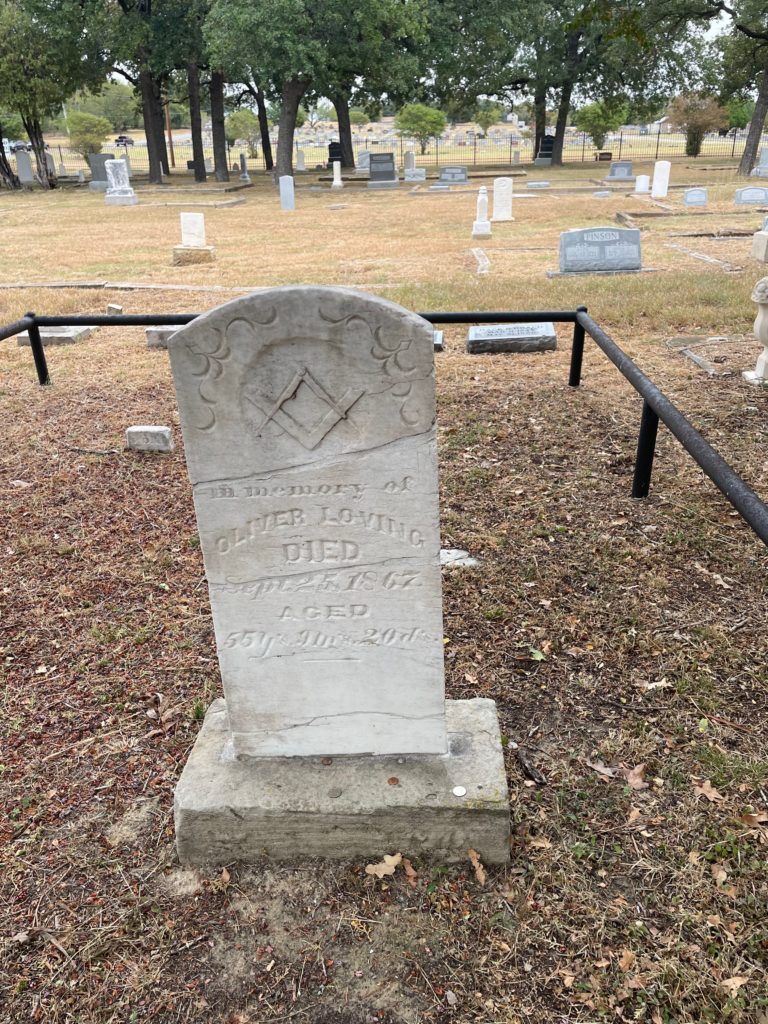Erik Visits an American Grave, Part 1,267
This is the grave of Oliver Loving.

Born in 1812 in Hopkins County, Kentucky, Loving grew up in the slave-holding, agricultural realities of the antebellum south. His family was just a pretty regular family really and he was seemingly just going to continue on the same path. He was farming in Muhlenberg County, Kentucky in the early 1830s. He seems to have kept doing that into the 1840s. But in 1843, he and his brothers decided to move to that newly “freed” land to expand white supremacy and slavery–Texas. He became a farmer out there and also hauled freight. He had a big family and had to work hard to support them.
In the 1850s, Loving decided to move further west in Texas to get involved in the cattle business. This put him at the front lines of the genocide against the Comanches that was at the heart of Texas settlement. The Comanches would not be put down until 1868, so Loving was taking his life in his own hands by venturing into their territory. But he managed to drive cattle to market for a few years. When the Civil War broke out, he was in the middle of driving cattle to Denver. The Army wasn’t going to let him past, but Kit Carson intervened here and allowed him to get his cattle up there to the mining camps. I’m not clear if Loving had particularly strong feelings about the war, but he was in Texas and certainly wasn’t going to complain about supplying cattle to the Confederacy. But when the Confederacy was crushed, Loving had nothing since he was being paid in Confederate money. Sad.
Now, during the war, Kit Carson had led American forces in their genocidal campaign against the Navajo. They, along with the Mescalero Apaches, were forced onto a horrible reservation at Fort Sumter, New Mexico. Probably a quarter of all Navajo died between 1864 and 1868, both on the Long Walk and at Fort Sumner. The water was alkaline, the land terrible, the provisions not nearly enough. For Loving, this was an opportunity. He and Charles Goodnight, another cattle rancher, decided to provide cattle to this reservation. The Army paid them well for it and they went into business together. After getting the gold from the government, Loving ran the rest of the cattle north to Denver, while Goodnight returned to Texas to get more. This also became the Goodnight-Loving Trail, which isn’t really a “trail” per se in the sense of the Oregon Trail or California Trail or Mormon Trail, but rather an established way to get cattle to market through eastern New Mexico and then up to Colorado and eventually Wyoming. They both then worked with John Chisum, a leading rancher outside of Fort Sumter who was one of these Old West figures who was really a thug, but was also a Republican and thus on the side of “law and order.” In fact, it was Chisum who helped convinced Pat Garrett to kill Billy the Kid in 1881.
In 1867, the three men were preparing another drive. Loving decided to move ahead of the herd to secure the contracts. Might have worked if he hadn’t run into the Comanche. They shot him with arrows. He didn’t die immediately. In fact, he managed to stumble into Fort Sumner, but he died of gangrene. He was 54 years old. Goodnight continued with the herd to Colorado. Business was business after all.
Oliver Loving is buried in Greenwood Cemetery, Weatherford, Texas. He was briefly buried at Fort Sumner, but Goodnight had his body brought back in 1868.
If you would like this series to visit Loving’s partners, you can donate to cover the required expenses here. Charles Goodnight is buried in what is now known as Goodnight, Texas, which is out on the panhandle. John Chisum is in Paris, Texas, today largely known for its replica of the Eiffel Tower with a red cowboy hat on top. Previous posts in this series are archived here.


